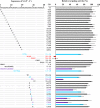An archaeal CRISPR type III-B system exhibiting distinctive RNA targeting features and mediating dual RNA and DNA interference
- PMID: 25505143
- PMCID: PMC4288192
- DOI: 10.1093/nar/gku1302
An archaeal CRISPR type III-B system exhibiting distinctive RNA targeting features and mediating dual RNA and DNA interference
Abstract
CRISPR-Cas systems provide a small RNA-based mechanism to defend against invasive genetic elements in archaea and bacteria. To investigate the in vivo mechanism of RNA interference by two type III-B systems (Cmr-α and Cmr-β) in Sulfolobus islandicus, a genetic assay was developed using plasmids carrying an artificial mini-CRISPR (AC) locus with a single spacer. After pAC plasmids were introduced into different strains, Northern analyses confirmed that mature crRNAs were produced from the plasmid-borne CRISPR loci, which then guided gene silencing to target gene expression. Spacer mutagenesis identified a trinucleotide sequence in the 3'-region of crRNA that was crucial for RNA interference. Studying mutants lacking Cmr-α or Cmr-β system showed that each Cmr complex exhibited RNA interference. Strikingly, these analyses further revealed that the two Cmr systems displayed distinctive interference features. Whereas Cmr-β complexes targeted transcripts and could be recycled in RNA cleavage, Cmr-α complexes probably targeted nascent RNA transcripts and remained associated with the substrate. Moreover, Cmr-β exhibited much stronger RNA cleavage activity than Cmr-α. Since we previously showed that S. islandicus Cmr-α mediated transcription-dependent DNA interference, the Cmr-α constitutes the first CRISPR system exhibiting dual targeting of RNA and DNA.
© The Author(s) 2014. Published by Oxford University Press on behalf of Nucleic Acids Research.
Figures




References
-
- Bolotin A., Quinquis B., Sorokin A., Ehrlich S.D. Clustered regularly interspaced short palindrome repeats (CRISPRs) have spacers of extrachromosomal origin. Microbiology. 2005;151:2551–2561. - PubMed
-
- Mojica F.J., Diez-Villasenor C., Garcia-Martinez J., Soria E. Intervening sequences of regularly spaced prokaryotic repeats derive from foreign genetic elements. J. Mol. Evol. 2005;60:174–182. - PubMed
-
- Pourcel C., Salvignol G., Vergnaud G. CRISPR elements in Yersinia pestis acquire new repeats by preferential uptake of bacteriophage DNA, and provide additional tools for evolutionary studies. Microbiology. 2005;151:653–663. - PubMed
-
- Jansen R., van Embden J.D.A., Gaastra W., Schouls L.M. Identification of genes that are associated with DNA repeats in prokaryotes. Mol. Microbiol. 2002;43:1565–1575. - PubMed
-
- Makarova K.S., Grishin N.V., Shabalina S.A., Wolf Y.I., Koonin E.V. A putative RNA-interference-based immune system in prokaryotes: computational analysis of the predicted enzymatic machinery, functional analogies with eukaryotic RNAi, and hypothetical mechanisms of action. Biol. Direct,. 2006;1:7. - PMC - PubMed
Publication types
MeSH terms
Substances
LinkOut - more resources
Full Text Sources
Other Literature Sources
Molecular Biology Databases
Research Materials

